If you’re planning a trek to Everest Base Camp, you’ll need to plan a bit in advance. You’ll be spending quite a few days above the tree line in a remote National Park. As such, it is essential that you are well prepared and efficient in what items you decide to bring along. That is why I created this ultimate Everest Base Camp packing list.
Throughout my trek, I quickly realized which items were essentials, which were “nice-to-haves” and which were not necessary. I
Without further ado, here is my complete Everest Base Camp packing list.
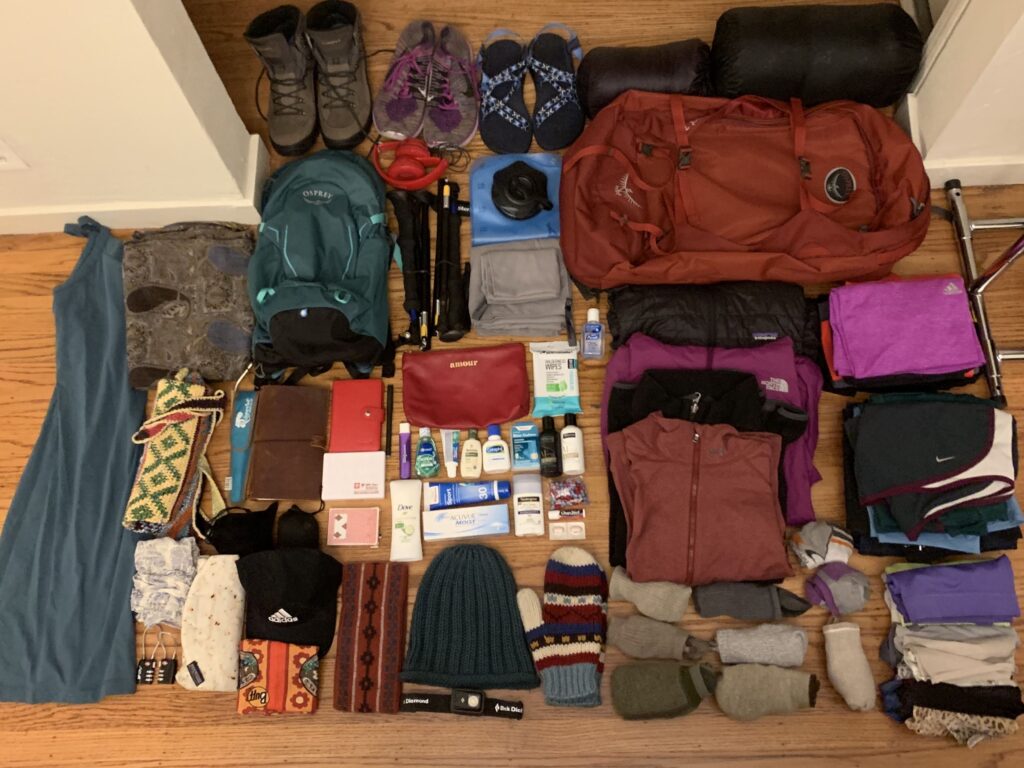
Everest Base Camp: Know before you go:
- The Everest Base Camp trek is basically one very long hike. As such, you will not need any sort of intense climbing gear – crampons, ice axes, etc.
- Most treks begin with a flight to the tiny Lukla airport in an even tinier airplane. There is a weight restriction of 30 lbs (13.5 kg) for all checked baggage on the plane.
- If you have ‘non-hiking’ clothing, you can leave them locked in your Kathmandu accommodation and collect them again once you are back in the capital city.
- When it comes to clothing, the name of the game is layers, baby-boo. The microclimates in the Khumbu region can range from super hot and muggy to fantastically cold as you reach higher altitudes. Best to wear many layers, and shed them as you go.
- Finally, there is a expected level of etiquette in the Khumbu region. Shorts are a big no-no, and it is always preferable to air on the side of more coverage than less.
Okay! Knowing those main points, we can now begin the actual Everest Base Camp packing list.
Everest Base Camp Packing List
Step 1: Choosing a pack
We’ll begin with choosing a pack to bring on trail. As mentioned before, you’re going to need one “duffel” and one “daypack”. Below are my recommendations:
Backpack/duffel bag – This will be the pack that contains most of your belongings, particularly the ones that you don’t need to retrieve during the day.
- If you are hiring porters to carry your packs, you will need a duffel bag so they can squish it up tight next to several others. Some travel companies will even provide you with the duffel, so this is good to check beforehand.
- If you are trekking it alone, then you will want some sort of trekking backpack that can carry your belongings during the day. I recommend Osprey or Gregory as fantastic brands for this.
Day pack (that can hold a camelbak bag) – As you’re traveling, you’ll want a daypack where you can store all of the items you might need to reach for during a day of hiking (sunscreen, hat, handsoap, etc).
- You’ll want to select a daypack that can hold a camelbak water bottle, as this is the item that you’ll be reaching for the most throughout the day. MUCH easier to have a straw to constantly sip through. I recommend Osprey once again for your daypack.
If your pack does not come with one automatically, I recommend purchasing a rain cover for your pack. The last thing that you want to be dealing with on trail is soaked and squishy gear. Keep this rolled up and in the bottom of your daypack in the event that it rains while you are on trail.
Step 2: What to pack in your duffel bag
These are items that will go in your duffel bag (if you have a porter) or your large backpack (if you are trekking alone). You will not need these items during the day.
IMPORTANT: Do not put your computer or breakable electronic devices in your duffel if you are traveling with porters. Duffels are carried by porters 2-3 at a time and, as such, they need to squish them together real tight to make sure they are secure. This tightening could damage breakable items, so they are better carried by you in a day pack.
- Essential: Hiking boots – THIS is the most important thing you can purchase for your trek. They will be your saving grace, or your achilles heel, depending on the brand you purchase. Make sure that you get a pair with solid ankle support, and be sure to break them in a bit before taking off. I recommend Iona as a fantastic brand.
- Essential: Trekking pants (x2) – Shorts are a big no-no in the Khumbu region, and may be seen as disrespectful. For that reason, trekking pants are the way to go. You’ll want pairs that are breathable and light, as it can be a bit toasty at lower altitudes.
- Essential: Dri-fit short sleeve shirts (x2) – Dri-fit is a great option, as it will wick away most of the sweat quickly, and will allow you to stay cool.
- Essential: Dri-Fit long sleeve shirt (x1) – I recommend carrying one long-sleeve layer as well, just in case it is a bit chillier one day.
- Essential: Long hiking socks (x3) – You’ll want to select hiking socks that cover your entire foot so your hiking boot is not rubbing at all on your ankle.
- Essential: Warm thermal socks (x2) – One for hiking at high altitudes, and one for wearing with your sandals or gym shoes while you are staying at tea houses.
- Essential: Nanopuff jacket (x1) – This should be super light, and be able to be squished down into your day pack for easy access
- Essential: Windbreaker / waterproof jacket
- Essential: Wind pants (x1) – You’ll want one pair of pants that are fully and completely wind and rain proof.
- Essential: Long sleeve base layer (x1) – You should bring one wool, long-sleeve base layer to wear underneath other clothing as you get closer to higher altitudes.
- Essential: Underwear (x5) – Get the ones that wick away moisture.
- Essential: Sports bra (x2)
- Essential: Shoes for tea houses and zero days (tevas, birkenstocks, or sneakers) – You’ll need one pair of shoes that can easily slip on and off for your evenings in the teahouses. This could either be a pair of comfortable sneakers, or a pair of slip on / slip off sandals.
- Essential: Sleeping bag!! – I recommend packing a 3 or 4 season sleeping bag – preferably one that can be crushed down to a small size when not in use. Mountain Hardware and Nemo make great bags, if you’re looking for good investment purchases.
- Essential: Headlight – I purchased this one from Black Diamond.
- Essential: Quick dry towel – You’ll want to pack one microfiber body towel to use after showering. Microfiber towels dry quickly, so you won’t be hiking with it soaked.
- Essential: Tip for guides and porters – You’ll want to tip your guides and porters in cash following the trip. I recommend $200USD in smaller bills to divide up after the trek. This amount can be in US dollars, or rupees (if you can get it converted beforehand)
- Essential: Travel plug adapter – When traveling internationally, you’ll need to make sure that your electronics have the correct power plugs for the outlet. A great solution is an international power converter like the one found here
- Essential: Winter hat
- Essential: Baseball hat
- Essential: Light inner gloves
- Essential: Heavy winter gloves
- Recommended: Zip up fleece (for sleeping and maybe hiking)
- Recommended: Leggings (x1-2) – Leggings are also not the best for trekking, but I recommend packing a pair to sleep in. They are also excellent for layering under your trekking pants when it gets a bit colder at higher altitudes.
- Recommended: Shorts (x1 for sleeping only – optional) – You may consider bringing a pair of running shorts to sleep in. I tend to sleep very hot so, at lower levels, having a pair of shorts came in super clutch.
- Recommended: Deck of cards – You’ll have a lot of downtime in tea houses. Consider bringing a pack of cards for fun! Uno was a blast for us.
- Recommended: fanny pack – If you don’t want to carry your day pack around while you are visiting villages along the route, a fanny pack is a good option.
- Recommended: Snacks – Having snacks along trail is a must, but you can absolutely purchase things to nibble on along the way. Note that at higher altitudes, the cost can be astronomical. That is why I recommended bringing a few along in your bag.
- Optional (gaiters) – I didn’t pack gaiters, and I don’t think they’re entirely necessary. But if you want to make sure you’re keeping all the dust out of your shoes, consider bringing them
- Optional: Lock – If you have anything that you want to lock up in tea houses or during the day for extra peace of mind, consider bringing a pack lock.
- Optional: Spare memory card – If you’re bringing a camera (video or otherwise), consider bringing a spare memory card, as internet and electricity can be expensive and sparse at higher altitudes.
- Optional: oximeter – These devices help you measure your blood oxygen levels. Your guides should have them, but it is something to consider if you are setting off alone.
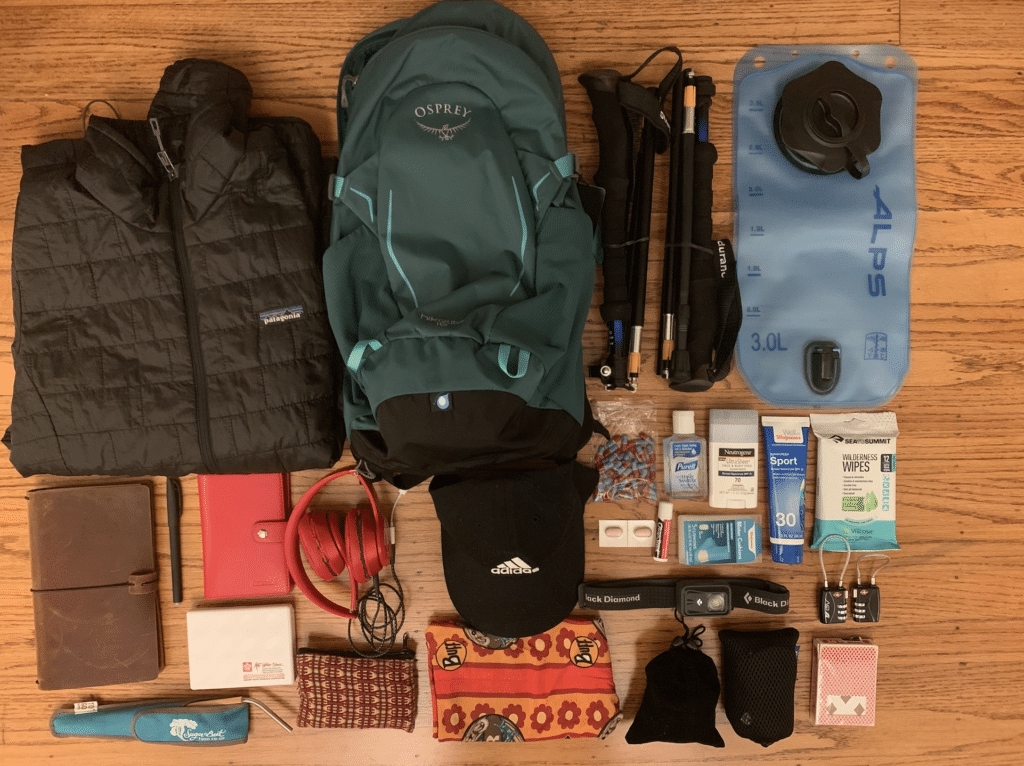
Step 3: What to carry in your day pack
These are all of the items that you will carry with you on your daily hikes. You should only bring items that you will reach for throughout the day. And LOTS and LOTS of water.
- Essential: Buff – Wear this around your neck and over your mouth and throat when it starts to get dusty. Bonus points if it’s a survivor buff!
- Essential: Sunglasses (high UV)
- Essential: Camelbak – Preferably a model like this one here. You’ll chug 2-3 of these minimum per day, so make sure you have it handy!
- Essential: Water bottle (no straw) – At higher altitudes, camelbak straws can freeze. Have 1-2 water bottles handy, like this Nalgene
- Essential: Iodine (or water purifying system) – Water tablets, drops, or a Steristraw should do the trick.
- Essential: Sunscreen – Particularly face sunscreen. Sun and wind burns are no joke up there.
- Recommended: trekking poles – I brought ‘em, didn’t use ‘em. But many others on my trek did. It’s your personal preference!
- Recommended: Waterproof bag – If you have documents or items that you’re worried about getting wet, you might consider bringing a waterproof bag.
- Essential: Phone
- Essential: Portable phone charger
- Recommended: Charging chords – Make sure you have all cables for any electronics you are bringing
- Optional: Camera – We used our phone cameras and they worked super well. If you’re into photography, consider taking your camera along with you
- Optional: Computer – I wouldn’t recommend bringing this. But up to you.
- Essential: Passport
- Essential: Money (in rupees / cash) – There are far and few ATMs along the trek, and almost everything needs to be paid for in cash. Make sure you stock up in Kathmandu. I recommend bringing a couple of hundred, as this is what you will use to purchase all food or necessary items along the route
- Recommended: Travel insurance – Sort this out before you go. Accidents happen, so make sure you are covered in case they do!
- Essential: Toilet paper – This was an item we didn’t think we would need, and ended up using constantly. Some of the tea houses along the route don’t have toilet paper handy, which can be problematic. I recommend unraveling a bit of the roll and storing it in a Ziploc bag in your day pack just in case.
- Essential: Hand sanitizer
- Recommended: snackssss – Pack 2-3 granola bars in your daypack in case you get hungry along the way
- Optional: electrolyte booster – These tablets are not necessary, but make the iodine/chlorine purified water taste so much better. Plus, they give you a little boost of energy
- Essential: Trekking permit (if going solo) – You’ll need to obtain a permit to hike in the park. If you are going as part of a tour, they should have this settled for you.
- Essential: Nepal visa – This is obtained at the Nepal airport when you first arrive. Just be aware that the lines can get looooong.
- Recommended: Copy of passport
- Recommended: Local SIM card – You can purchase this in Kathmandu
- Essential: Lip Balm
- Recommended: Hand lotion
- Recommended: Journal – I recommend spending some time at the end of each day writing out all of your memories and experiences. It is the best souvenir you can give yourself! I brought along this travel journal, and still look back on all my entries today!
- Recommended: Pen
- Pack your hats and gloves in your day pack, just in case!
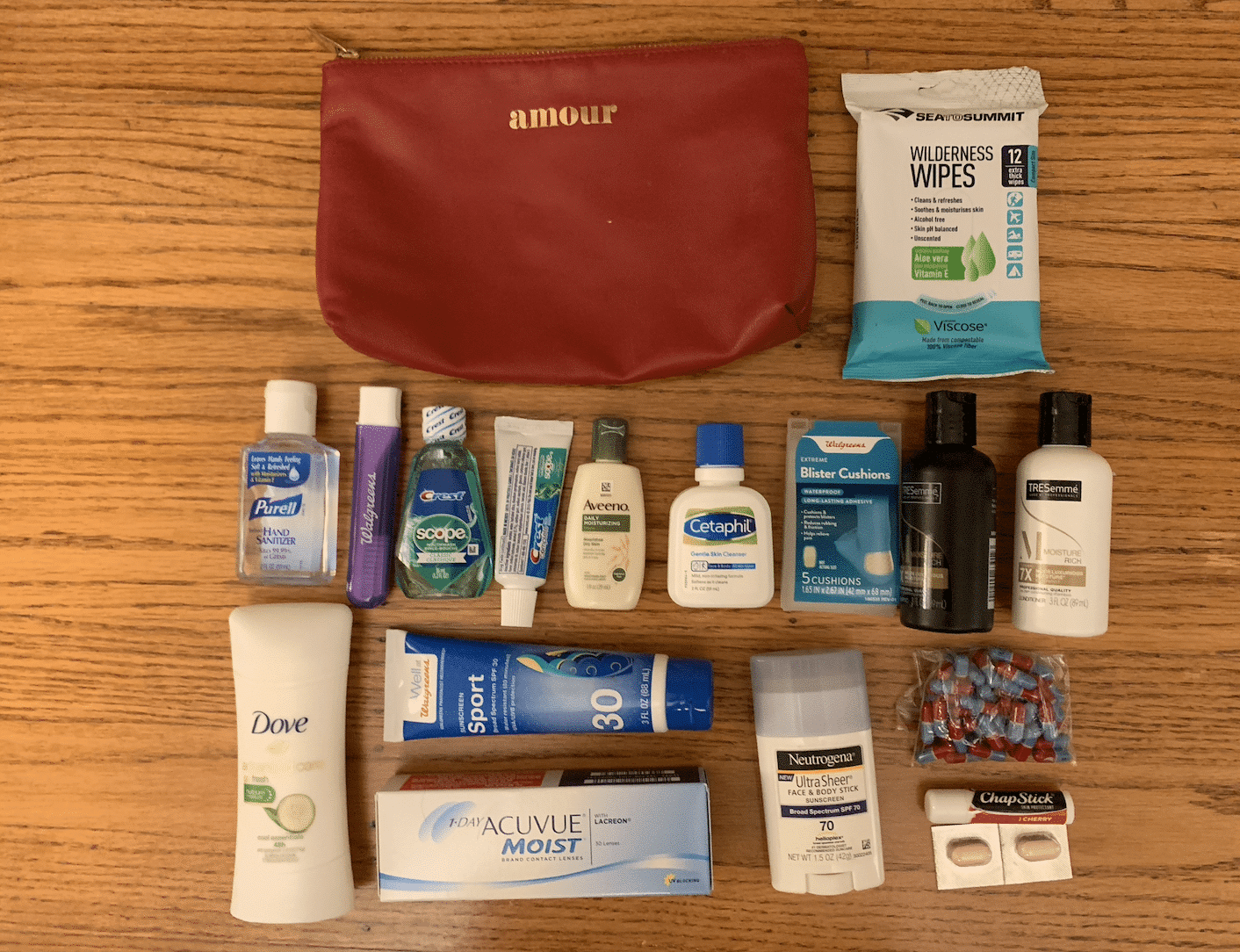
Step 4: What to pack in your toiletries kit
You should absolutely bring along a small pencil or make-up case full of toiletries. You don’t need a lot – but you should absolutely bring the essentials. These are probably the items that are most difficult to pick up once you take off for your trip (ex: contact lenses or necessary medications).
- Recommended: Diamox – Diamox is an oral medication that helps you adjust to altitude. Talk with your doctor about whether they recommend taking Diamox on the trail
- Essential: Medications – Again. Talk to your doctor about which medications to bring along.
- Recommended: First aid kit (build your own) – I threw some bandaids, neosporin, and a couple of blister pads in a small pouch. You might choose to bring more of less.
- Essential: Contact lenses
- Essential: Glasses
- Recommended: Baby wipes – A lot of accommodations don’t have showers. Totally okay. Just be ready to smell a little stinky! Baby wipes are a great way to rinse off a little bit of the scuzz
- Essential: Toothbrush and Toothpaste
- Optional: Retainer – If you’re on the Invisalign bandwagon or if you, like me, still have your retainer from middle school, bring it
- Essential: Chapstick
- Essential: Deodorant
- Optional: Tums or other stomach soothers – I didn’t pack tums, but someone on my trip did. I was thankful for their proactivity after an unfortunate run-in with spicy ra-ra noodles at 5,000 meters. Dumb user error alleviated by Tums. Score.
- Optional: Strong antibiotic dose (do not use unless absolutely necessary) – You can get this from your doctor. Basically, it is an aggressive antibiotic pill only to be used if things go south very quickly. I’m talking, can’t-get-out-of-bed-and-all-the-fluid-has-leaked-out-of-my-body kind of bad. Don’t take this unless you need to. I didn’t take mine.
- Recommended: Biodegradable soap
- Recommended: Shampoo/conditioner
Step 5: What to leave behind in Kathmandu
These are the items that you won’t need on your trek, but you might want to have once you make it back to Kathmandu.
- Optional: Day dress – When you get back, you’ll likely want to have a nice dinner or wander about the capital. A day dress solves that problem!
- Optional: Nice pants and/or shirt (cotton or loose fitting) – See above
- Optional: Sandals (nicer) – A nice pair of sandals is a good thing to pack! But don’t bring them on trail.
- Optional: Empty purse – You’ll want a purse to take around the capital so you don’t have to wander around with your full trekking pack. Throw an empty purse in the luggage you are leaving at the hotel.
That’s all, folks!
Hopefully this Everest Base Camp packing list gives you a good idea of what to bring along on your adventure!
Have you hiked to Everest Base Camp? What does your Everest Base Camp packing list look like? Drop a comment below with ideas!
Check out my other posts on Everest Base Camp for more information!
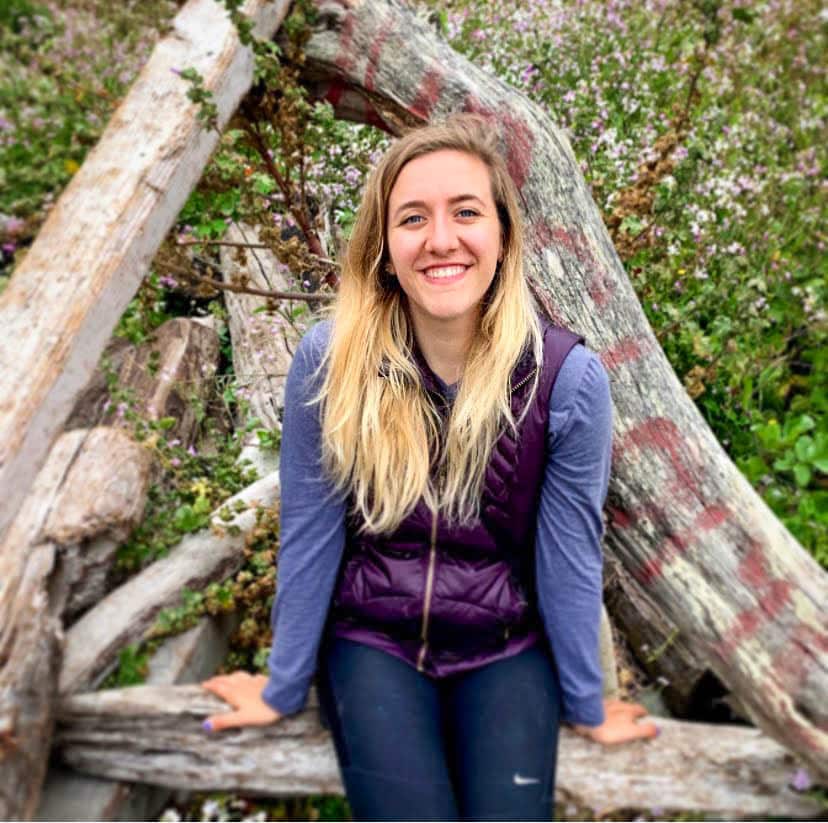
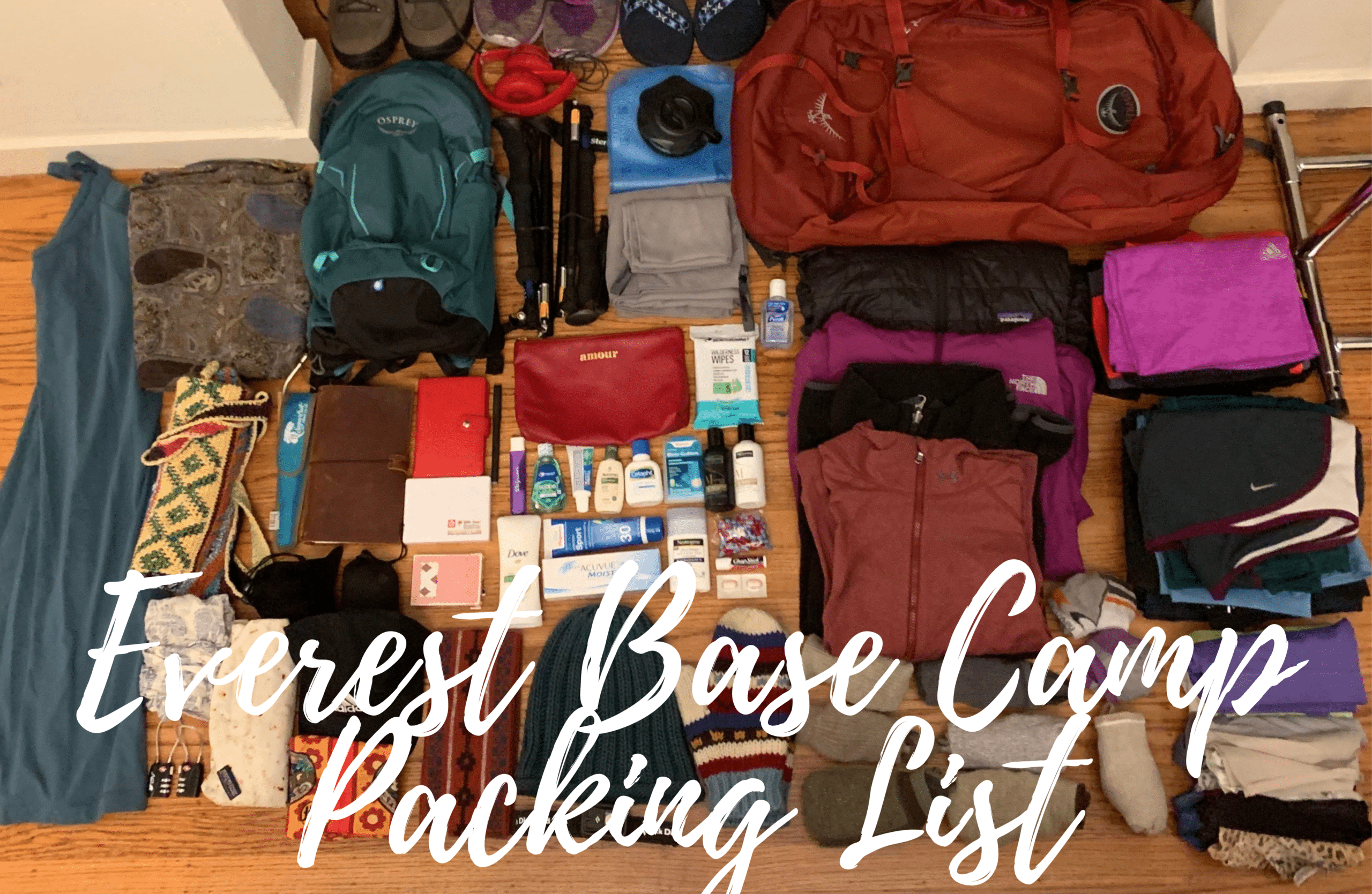
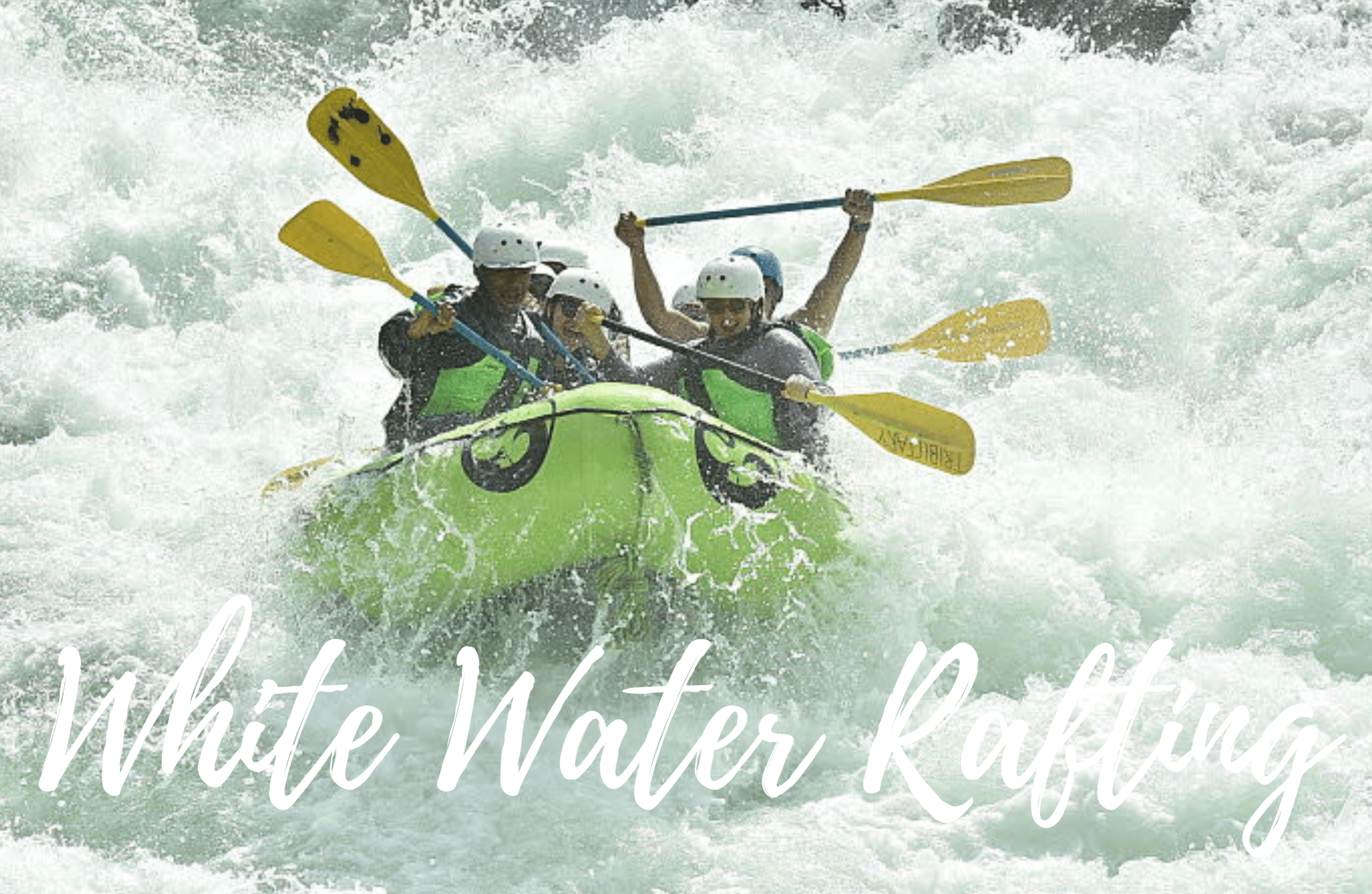
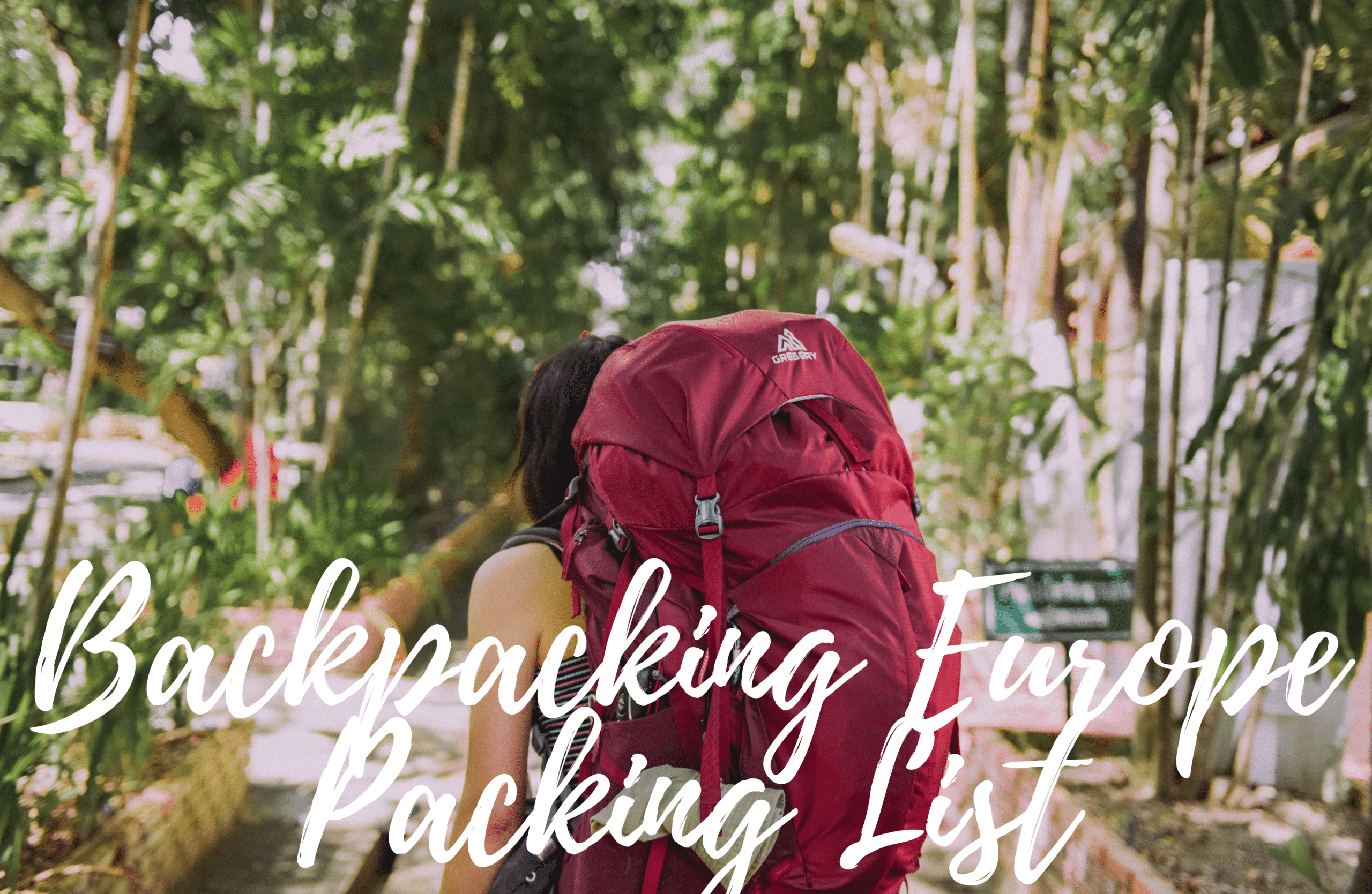
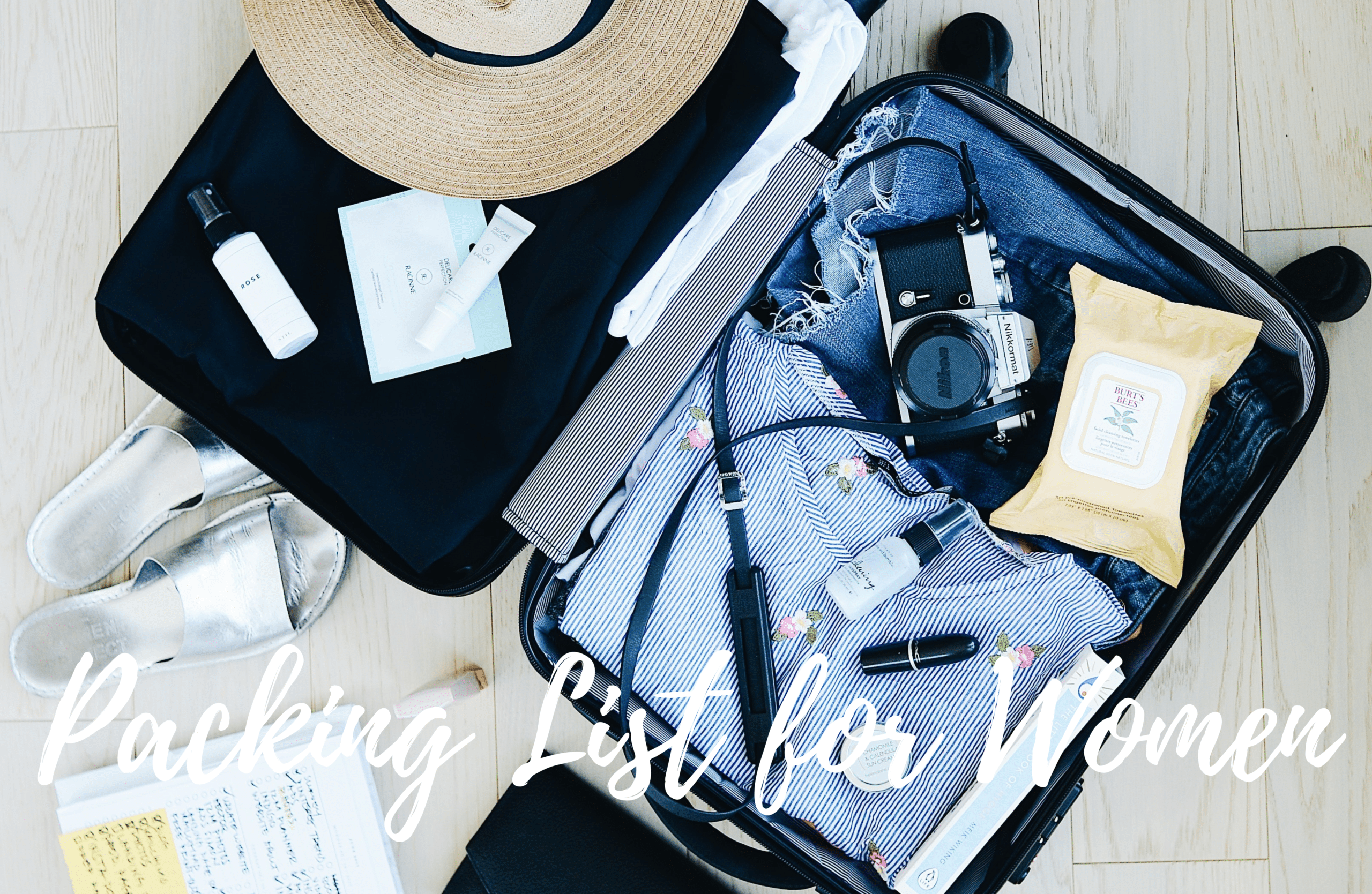
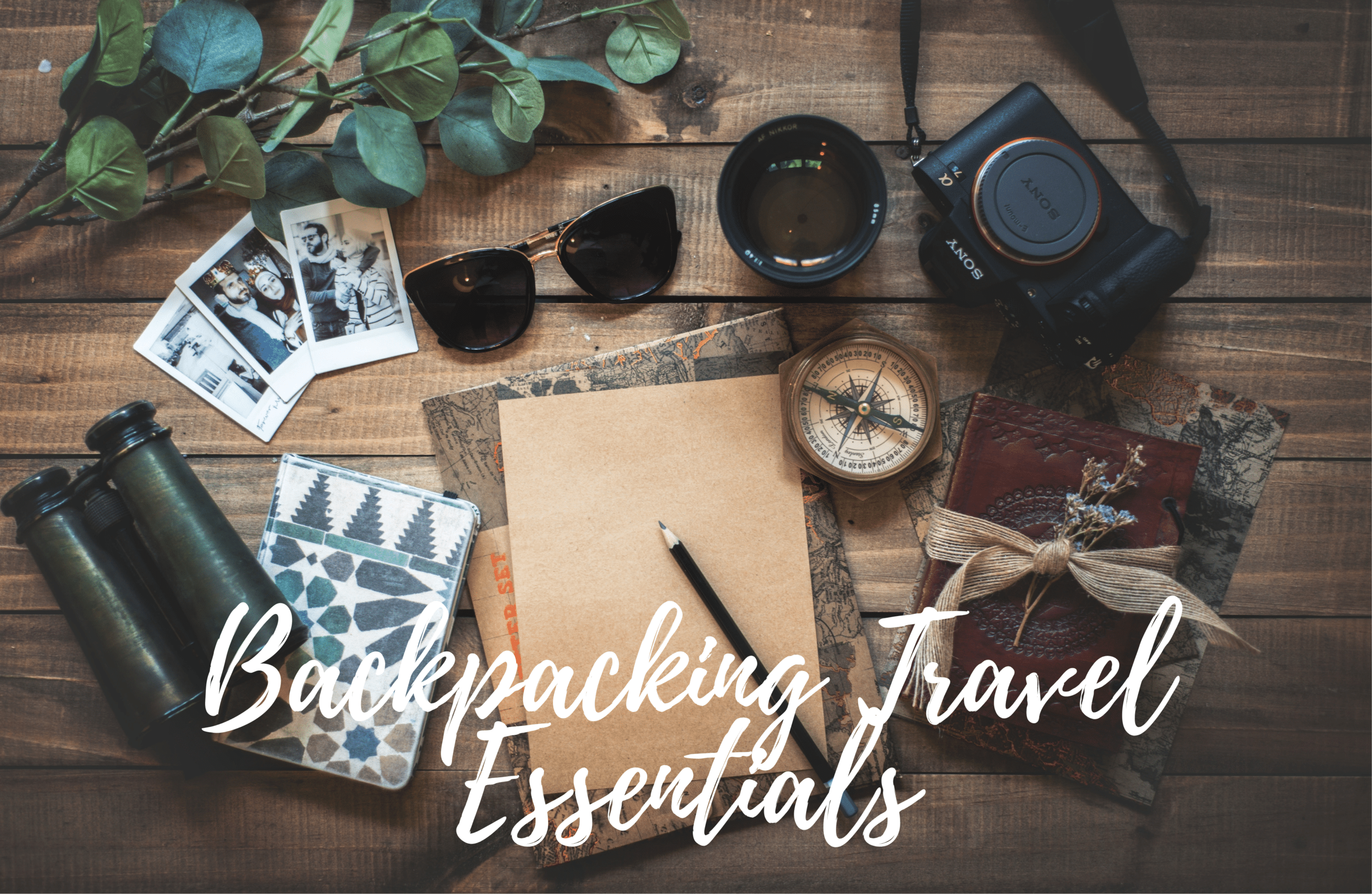
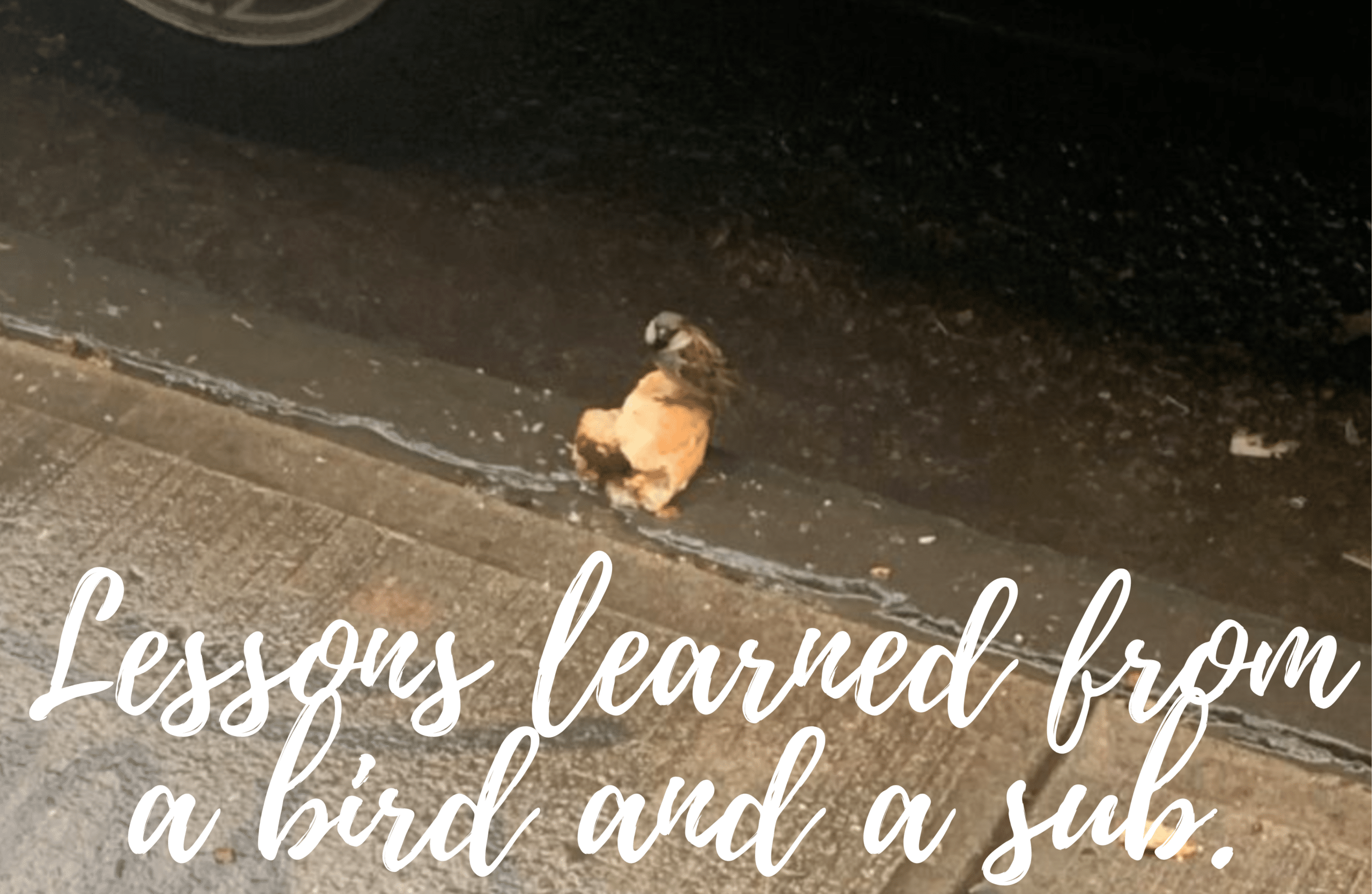
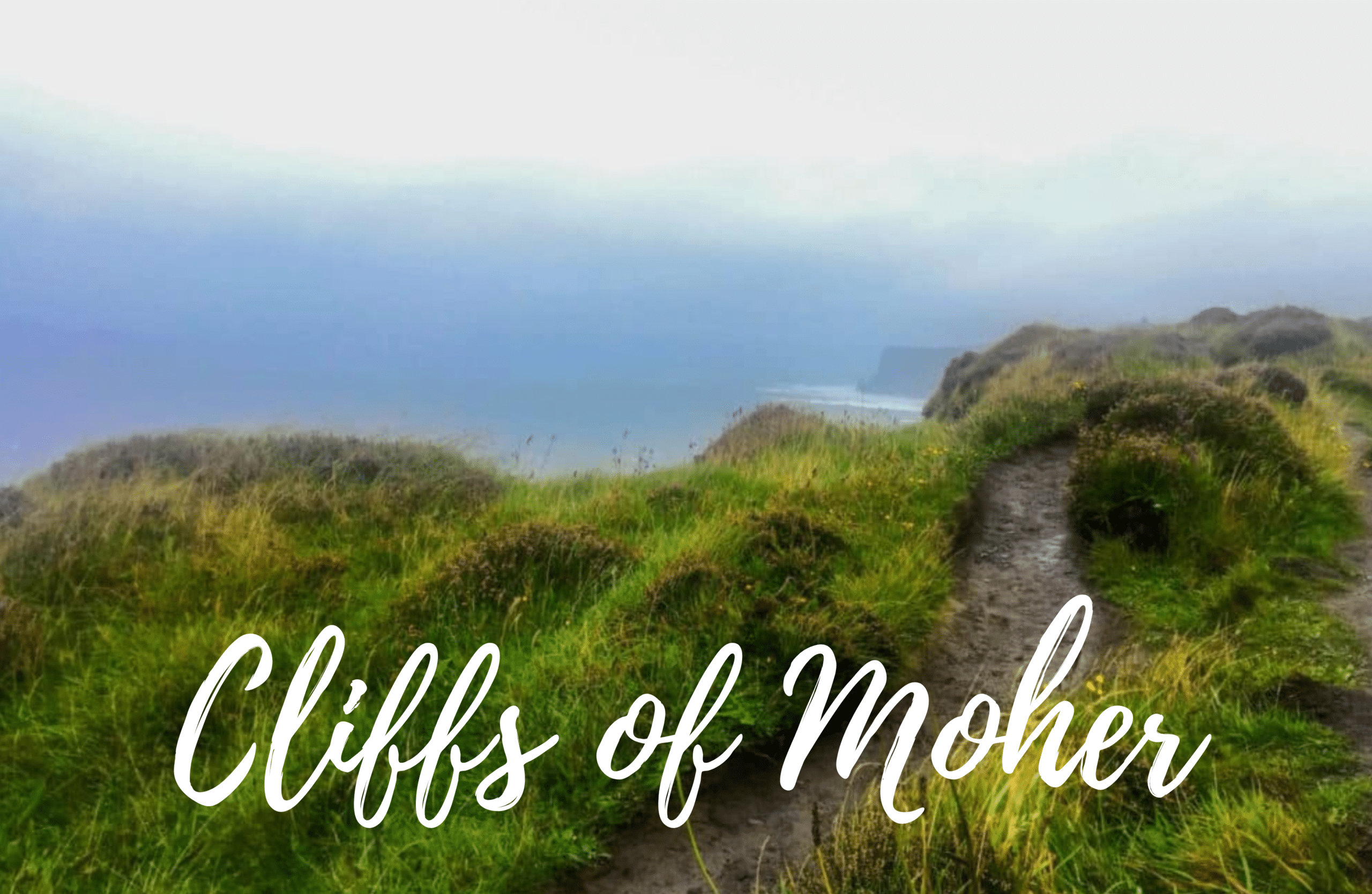
0